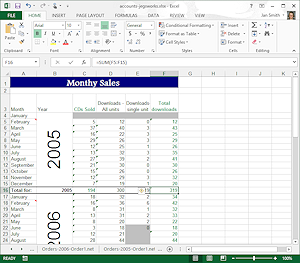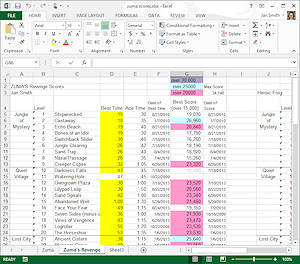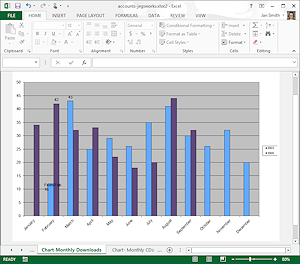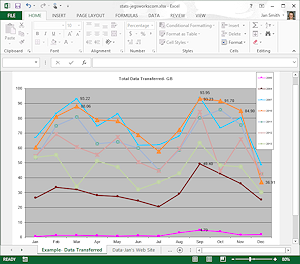Jan's Working with Numbers
Using Excel 2007, 2010, 2013, & 2016
The best software for working with piles of numbers is a spreadsheet program. Such a program is designed to make it easy to arrange and analyze numbers, like listing columns of numbers, sorting, doing calculations, and making charts from the numbers.
In some ways spreadsheet programs (like MS Excel) are similar to word processing programs (like MS Word) that you are more likely to have used. In both you can: create titles, type sentences and paragraphs, arrange data in rows and columns, format numbers and text, set the margins and orientation of the page, cut, copy, paste. But each type of software has frequent tasks that are not so easy to do in the other type. Each has its special choices for printing. Using a program that is designed for the particular task is worthwhile.
Examples of worksheets and charts:




Worksheets and Charts (Excel 2013)
What you need for this tutorial:
This set of lessons will teach you to use the most commonly used features in spreadsheet software. The directions are based on Microsoft Excel 2007, 2010, 2013, and 2016, which are quite similar. What you learn will help you with other spreadsheet programs, too.
- Basic Windows skills: The skills covered in the Working with Windows
 lessons- using a mouse
to click, double-click, drag, and right click; parts of a window; moving,
resizing, maximizing and minimizing a window; scrolling; using the folder
tree; creating and managing folders; naming files; opening a program; opening
and saving files; using dialog boxes; using Help; printing.
lessons- using a mouse
to click, double-click, drag, and right click; parts of a window; moving,
resizing, maximizing and minimizing a window; scrolling; using the folder
tree; creating and managing folders; naming files; opening a program; opening
and saving files; using dialog boxes; using Help; printing. - Typing skills: You need to be familiar with the computer keyboard and have some skill in typing to do these exercises in a reasonable amount of time.
- Word processing experience: The directions assume that you have
at least some experience with creating documents with a word processor.
You will need the basic skills: entering, deleting, and moving text; choosing
a font, font size, font color; headers and footers, etc. Word processing is
covered in Working with Words
 .
. - Resource files: Files that you need to
create the documents in the projects are provided for download in a
zip file and are also available online separately
 . Your instructor may have put
these files on your computer already.
. Your instructor may have put
these files on your computer already.
To get these resource files,
 click on the following link to download a zipped set of files:
click on the following link to download a zipped set of files:A download dialog will appear. Choose "Save this program to a disk" if you want to unzip later. Choose Open to let Windows or your own zipping software unzip the files. Choose a folder on your hard drive for the extracted files.
To extract later, find the zipped file in an Explorer window and double-click it. Windows or your own zipping software will then unzip it.
Duplicate files: Some of the resource files have duplicates in different Office file formats. Be careful to choose the file that the directions tells you to use.
- Removable File Storage: USB drive
You need removable storage for a working copy and a backup copy of your documents.
If you have a computer of your own, keep an up-to-date copy of your work on your home computer, too. Another good location is at an online storage site like Dropbox, Google Drive, or OneDrive. Most such services have a free account with a significant amount of storage.
Start good backup habits early and you won't kick yourself later when your files are lost or corrupted.
USB drive: Recommended
Called by many different names: flash drive, flash pen, thumb drive, key drive, jump drive, and mini-USB drive. A USB drive is an excellent choice for storing your class work.Before you buy:
Check the following for both the classroom computer AND your home computer-
- Computer does have USB ports.
- You are allowed to use one of the USB ports.
- You can physically get to the USB port.
Some are on the the back of the computer case. - Operating system will recognize a USB drive.
All recent versions of Windows can recognize USB drives and install software to operate them. - Physical arrangement of USB ports - Are they side by
side? one above the other?
Some USB drives are wider or thicker than others and may not fit all port arrangements, especially if a neighboring USB port has something plugged into it. Some drives come with a short extension cable. What speed can the ports handle? There are currently 3 flavors of USB - 1.1, 2.0, and 3.0, which is much, much faster than the older versions.
If you do not have a computer at home, consider buying 2 USB drives so that you can use one to keep a backup copy of your work. Don't lose them both at the same time!
 The exercises often build on documents
you have already created. Do not delete your exercises until you have
finished all the projects.
The exercises often build on documents
you have already created. Do not delete your exercises until you have
finished all the projects.
- Spreadsheet Software: To create spreadsheets you use a spreadsheet program, like MS Excel, Corel Quattro Pro, or Lotus 123, or access to an online spreadsheet program like Google Spreadsheet. All spreadsheet programs have some basic similarities. They vary considerably in what special features they include, just as word processors do. If you are not using Excel 2007, 2010, 2013, or 2016, the directions for the projects and exercises will likely not work for you. In that case, use your software's Help files to find out if there is an equivalent method or tool.
Icons
![]() Hands-on topic, (symbol in the menu) where you will have
Step-by-Step directions.
Hands-on topic, (symbol in the menu) where you will have
Step-by-Step directions.
![]() Tip - something you might find useful to know.
Tip - something you might find useful to know.
![]() Warning about possible problems.
Warning about possible problems.
![]() Problem and Solution, for what to do in case of trouble
Problem and Solution, for what to do in case of trouble
![]() Save or retrieve a file (Icon is a USB flash device. You may be using something else)
Save or retrieve a file (Icon is a USB flash device. You may be using something else)
![]() backup
copy of your Class documents
backup
copy of your Class documents
![]() your
storage device is too full to save new documents
your
storage device is too full to save new documents
![]() Print something.
Print something.
![]() Keyboard shortcut or method to do something
Keyboard shortcut or method to do something
![]() Link to a page or file that is part of this site
Link to a page or file that is part of this site
![]() Link to a page or file that is NOT part of this site. You must be connected to the Internet to view.
Link to a page or file that is NOT part of this site. You must be connected to the Internet to view.
Versions: Sections that apply to a certain version of Excel will be labeled and will usually have background color.
Multiple Versions: Sections that apply to two or three versions but not all will show nested background color with the most recent version showing the most color.
Disclaimer: All names, addresses, and phone numbers
used in the lessons and exercises are fiction! Any similarity to a real person,
business, or place is a coincidence.
The author cannot be held responsible for any damage to hardware, software,
or data resulting from your attempts to follow the directions.
